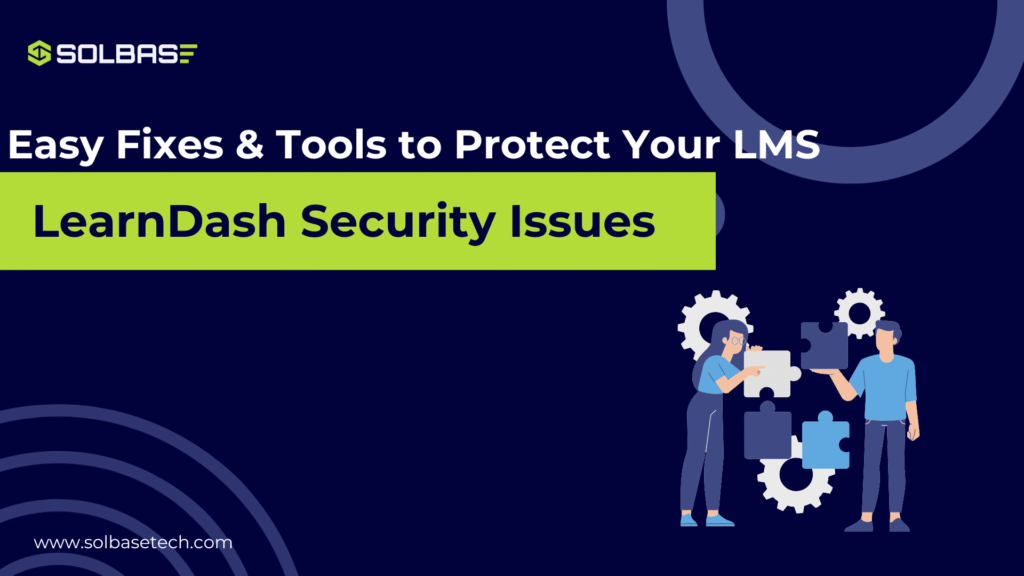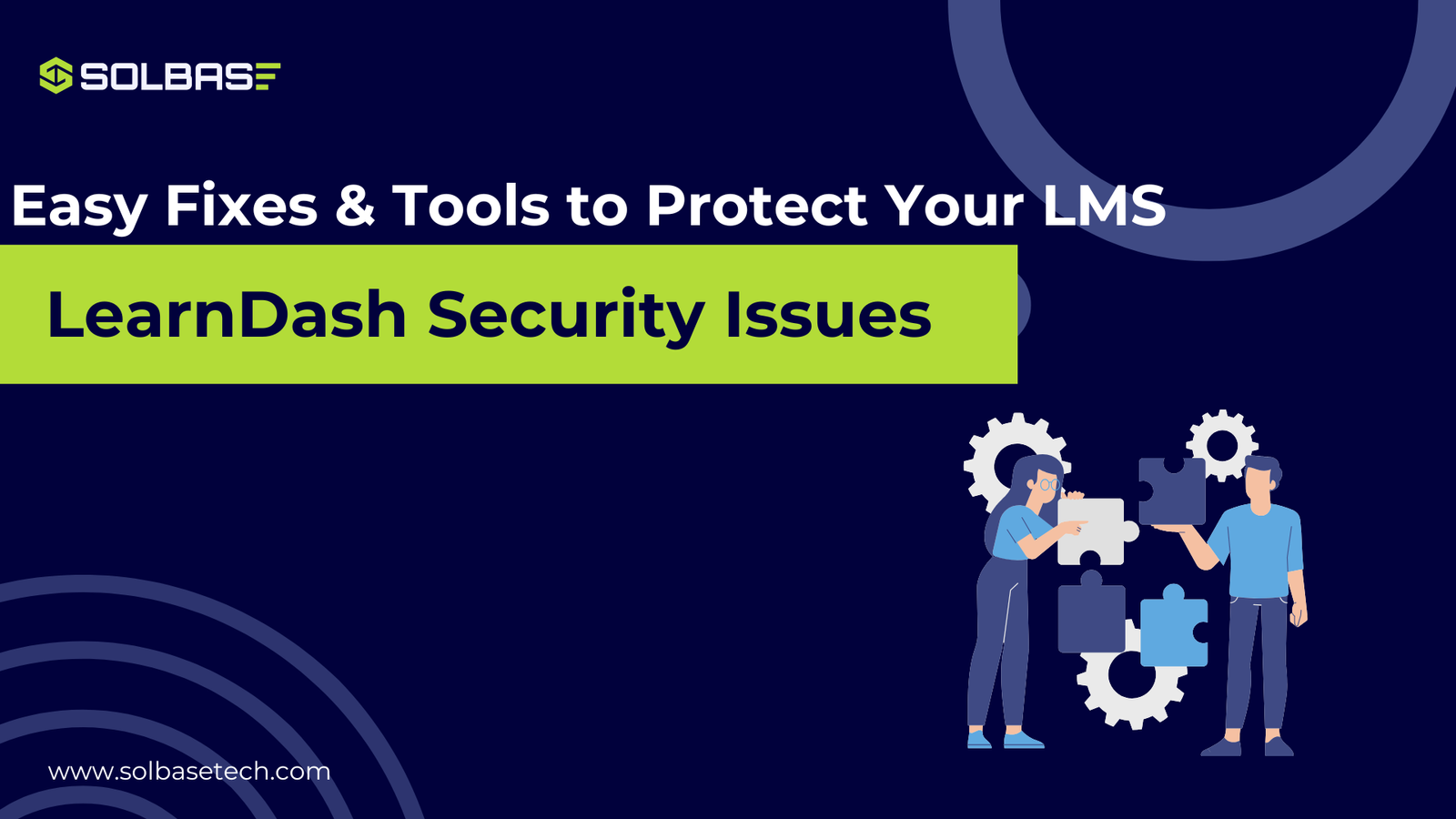How to Resolve LearnDash Security Issues in 2025?

Your LearnDash course is valuable, but LearnDash security is the most important thing. If your course is not safe, all the time and effort you spent can be wasted. Every day, thousands of WordPress-based LearnDash sites face cyber risks that can erase all that work within minutes.
The good news is that you can stop these problems with clear and simple Learndash Security Plugins. In this guide, you will learn how to create strong security in 2025 and keep your data, your students, and your website safe.
Top LearnDash Security Threats You Should Know
LearnDash is built on WordPress, which powers more than 40% of all websites on the internet. This huge popularity also makes it a favorite target for hackers. Cybercriminals usually look for easy ways to get in, like outdated plugins, weak passwords, or unsafe themes. Once they break into your site, they can:
- Steal your users personal data and course information
- Add harmful or hidden scripts to your pages.
- Lock you out of your own website.
Small and medium course creators are most at risk because they often use shared hosting or rely on default WordPress settings. Without strong LearnDash security, even one small mistake can expose student details, quiz results, or payment data.
To keep your LearnDash site safe, it’s important to understand these risks early, so you can fix them before they turn into costly problems.
Top Mistakes Course Creators Make
Many LearnDash site owners unknowingly create security gaps that make them easy targets.
Common mistakes include:
- Using weak or reused passwords for admin access
- Ignoring WordPress and plugin updates
- Giving unnecessary admin permissions to team members or instructors
- Running sites on cheap shared hosting with no malware protection
- Skipping regular backups and security scans
Each of these mistakes gives attackers more opportunities to exploit your website.
The good news is that fixing them is simple once you have a plan on how to secure your learndash.
How To Secure Your LearnDash LMS Website
3.1 Choose a Secure Hosting Provider
Your hosting provider is your first line of defense. Look for managed WordPress hosting that includes malware scanning, firewalls, and automatic backups. Services like Kinsta, Cloudways, or WP Engine specialize in secure WordPress environments and can prevent most attacks before they reach your LearnDash site.
3.2 Enable SSL (HTTPS)
An SSL certificate keeps the connection between your learners and your website safe and private. It encrypts all data such as login details, quiz results, and payment information, so hackers can’t steal or read it.
Without SSL, attackers can easily intercept sensitive data while it’s being sent between your site and your users.
Most hosting companies already include a free SSL certificate, but if yours doesn’t, you can get one easily from Let’s Encrypt. Always make sure your website URL starts with “https” instead of “http” this shows that your LearnDash site is secure and trusted.
3.3 Keep Plugins, Themes, and Core Updated
Outdated plugins are one of the biggest reasons hackers attack LearnDash sites. When your WordPress core, LearnDash plugin, or extensions are not updated, they leave security holes that attackers can easily use.
To stay safe:
- Update WordPress, LearnDash, and all plugins regularly.
- Turn on automatic updates if your host allows it.
- Delete unused plugins or themes, even inactive ones can create risks.
Keeping everything updated is one of the easiest and most effective ways to protect your LearnDash website from hackers and data loss.
If you’re also looking to improve your LMS functionality, check out our guide on the Best LMS Plugins for WordPress to make your site more powerful and efficient.
3.4 Manage User Roles and Permissions
Only give admin access to people who truly need it. LearnDash allows multiple roles like instructor, group leader, and student. Review permissions monthly and remove inactive users. Limiting access reduces the risk of accidental data exposure or intentional misuse.
3.5 Strengthen Login Security
Use strong passwords with random characters and avoid common phrases. Enable two-factor authentication (2FA) for all admins and instructors. You can also install a plugin that limits login attempts, so hackers cannot guess passwords repeatedly.
My Recommendation: I recommend using secure login tools with built-in 2FA support to protect your LearnDash dashboard from unauthorized access.
3.6 Install a Reliable Security Plugin
A dedicated security plugin monitors threats and automatically blocks suspicious activity. Wordfence, Sucuri, and Solid Security (previously iThemes Security) are popular options. They provide firewalls, malware scanning, and real-time alerts, making it easier to manage LearnDash security even if you’re not a technical expert.
3.7 Monitor and Audit Regularly
A secure site is not a one-time setup. Conduct regular audits using tools like WP Activity Log to track user behavior and detect unusual logins or changes. Security scanners like Patchstack can alert you if your LearnDash site has known vulnerabilities or outdated code.
Advanced Security Tips for Pro Users
If you manage multiple LearnDash courses or student groups, go beyond the basics.
- Use Cloudflare or another CDN to filter malicious traffic and improve performance.
- Add CAPTCHA or Google reCAPTCHA to login and registration forms.
- Disable file editing inside WordPress to prevent hackers from inserting malicious code.
- Use a web application firewall (WAF) to stop attacks before they reach your site.
These steps make your LearnDash data protection setup more resilient and reduce downtime in case of any attempted attacks.
What to Do If Your LearnDash Site Gets Hacked
If your LearnDash site is hacked by someone or you see any security threats, act fast.
- Temporarily take your site offline to prevent more damage.
- Contact your hosting provider for help identifying the problem.
- Scan your site using a malware removal tool.
- Restore a clean version from your most recent backup.
- Change all passwords and remove suspicious users.
- Recheck your plugins and re-enable 2FA.
Transparency builds trust, so if user data was affected, inform your learners promptly.
For an in-depth recovery guide, you can review resources on Sucuri.net, which provides detailed steps on WordPress malware cleanup.
Best Tools for LearnDash Security
| Purpose | Tool | Main Benefit |
| Firewall & Protection | Wordfence | Blocks malicious login attempts |
| Malware Scanning | Sucuri | Detects and cleans infected files |
| Backup | UpdraftPlus | Scheduled backups and easy restore |
| Monitoring | Patchstack | Finds plugin vulnerabilities |
| Login Management | Bitwarden | Secure password storage and sharing |
These tools can help you automate much of your WordPress LMS Security plan so that your team can focus on course creation instead of technical maintenance.
Conclusion for LearnDash Security
Building a secure LearnDash course in 2025 is not complicated, but it requires consistency. With the right setup and ongoing attention, your LMS can stay protected from most online threats. Focus on reliable hosting, regular updates, secure logins, and constant monitoring. A few hours of setup now can save your entire business later.
Need professional help securing your LMS? Book a consultation with our WordPress experts and we’ll help you protect your LearnDash site from all major threats.



